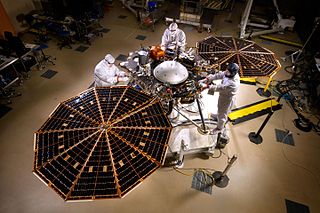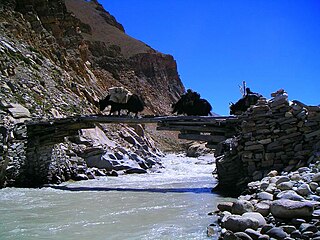
Engineering is the application of knowledge in the form of science, mathematics, and empirical evidence, to the innovation, design, construction, operation and maintenance of structures, machines, materials, software, devices, systems, processes, and organizations. The discipline of engineering encompasses a broad range of more specialized fields of engineering, each with a more specific emphasis on particular areas of applied mathematics, applied science, and types of application. See glossary of engineering.

Geotechnical engineering is the branch of civil engineering concerned with the engineering behavior of earth materials. Geotechnical engineering is important in civil engineering, but also has applications in military, mining, petroleum and other engineering disciplines that are concerned with construction occurring on the surface or within the ground. Geotechnical engineering uses principles of soil mechanics and rock mechanics to investigate subsurface conditions and materials; determine the relevant physical/mechanical and chemical properties of these materials; evaluate stability of natural slopes and man-made soil deposits; assess risks posed by site conditions; design earthworks and structure foundations; and monitor site conditions, earthwork and foundation construction.
A foundation is a category of nonprofit organization or charitable trust that will typically provide funding and support for other charitable organizations through grants, but may engage directly in charitable activities. Foundations include public charitable foundations, such as community foundations, and private foundations which are typically endowed by an individual or family. The term "foundation" though may be used by organizations not involved in public grant making.

A cantilever bridge is a bridge built using cantilevers, structures that project horizontally into space, supported on only one end. For small footbridges, the cantilevers may be simple beams; however, large cantilever bridges designed to handle road or rail traffic use trusses built from structural steel, or box girders built from prestressed concrete. The steel truss cantilever bridge was a major engineering breakthrough when first put into practice, as it can span distances of over 1,500 feet (460 m), and can be more easily constructed at difficult crossings by virtue of using little or no falsework.
Scott J. Shenker is an American computer scientist, and professor of computer science at UC Berkeley. He is also the leader of the Initiatives Group and the Chief Scientist of the International Computer Science Institute in Berkeley, California.

Gaziantep University is a public university in Gaziantep, Turkey. Gaziantep University has 10 faculties, containing a total of 22 academic departments, with a strong emphasis on scientific and technological research.
The Directive Principles of State Policy (DPSP) are the guidelines or principles given to the federal institutes governing the state of India, to be kept in citation while framing laws and policies. These provisions, contained in Part IV of the Constitution of India, are not enforceable by any court, but the principles laid down therein are considered irrefutable in the governance of the country, making it the duty of the State to apply these principles in making laws to establish a just society in the country. The principles have been inspired by the Directive Principles given in the Constitution of Ireland relate to social justice, economic welfare, foreign policy, and legal and administrative matters.
In geotechnical engineering, bearing capacity is the capacity of soil to support the loads applied to the ground. The bearing capacity of soil is the maximum average contact pressure between the foundation and the soil which should not produce shear failure in the soil. Ultimate bearing capacity is the theoretical maximum pressure which can be supported without failure; allowable bearing capacity is the ultimate bearing capacity divided by a factor of safety. Sometimes, on soft soil sites, large settlements may occur under loaded foundations without actual shear failure occurring; in such cases, the allowable bearing capacity is based on the maximum allowable settlement.
Dynamic load testing is a method to assess a pile's bearing capacity by applying a dynamic load to the pile head while recording acceleration and strain on the pile head. Dynamic load testing is a high strain dynamic test which can be applied after pile installation for concrete piles. For steel or timber piles, dynamic load testing can be done during installation or after installation.

A private foundation is a charitable organization that, while serving a good cause, might not qualify as a public charity by government standards. The Bill & Melinda Gates Foundation is the largest private foundation in the U.S. with over $38 billion in assets. Most private foundations are much smaller. Approximately two-thirds of the more than 84,000 foundations which file with the IRS, in 2008, have less than $1 million in assets, and 93% have less than $10 million in assets. In aggregate, private foundations in the U.S. control over $628 billion in assets and made more than $44 billion in charitable contributions in 2007.
Dr. Ralph Brazelton Peck was an eminent civil engineer specializing in soil mechanics. He was awarded the National Medal of Science in 1975 "for his development of the science and art of subsurface engineering, combining the contributions of the sciences of geology and soil mechanics with the practical art of foundation design".
In the eurocode series of European standards (EN) related to construction, Eurocode 7: Geotechnical design describes how to design geotechnical structures, using the limit state design philosophy. It is published in two parts; "General rules" and "Ground investigation and testing". It was approved by the European Committee for Standardization (CEN) on 12 June 2006. Like other Eurocodes, it became mandatory in member states in March 2010.

Harry Bolton Seed was an educator, scholar, former Professor at the University of California, Berkeley. He was regarded as the founding father of geotechnical earthquake engineering.

Suction caissons are a new form of fixed platform anchor that have a number of advantages over conventional offshore foundations, mainly being quicker to install than deep foundation piles and being easier to remove during decommissioning. Suction caissons are now used extensively worldwide for anchoring large offshore installations, like oil platforms, offshore drillings and accommodation platforms to the seafloor at great depths. In recent years, suction caissons have also seen usage for offshore wind turbines in shallower waters.
In philanthropy, donor intent is the purpose, sometimes publicly expressed, for which a philanthropist intends a charitable gift or bequest. Donor intent is most often expressed in gift restrictions, terms, or agreements between a donor and donee, but it may also be expressed separately in the words, actions, beliefs, and giving practices of a philanthropist. Donor intent is protected in American law regarding charitable trusts, and trustees' primary fiduciary obligation is to carry out a donor's wishes.
SAL Group of Institutions are educational institutes in Ahmedabad, Gujarat, India. They were administered by Adarsh Foundation established in 2009. Adarsh Foundation is CSR arm of the Shah Alloys Limited, a major steel production company of India.

Sajal K. Das is the Daniel St. Clair Endowed Chair Professor at the Computer Science department at Missouri University of Science and Technology (S&T). During 2008-2011 he served the US National Science Foundation as a Program Director in the division of Computer Networks and Systems. His research interests include wireless and sensor networks, mobile and pervasive computing, smart environments and smart health care, pervasive security, biological networking, applied graph theory and game theory. His research on wireless sensor networks and pervasive and mobile computing is widely recognized as pioneering. He is a Fellow of the IEEE.
Clyde N. Baker Jr. is an American geotechnical engineer who has received awards for his work to design advanced foundations supporting tall structures. He is a member of the National Academy of Engineering. In 2008, he received the Award of Excellence from Engineering News-Record.










